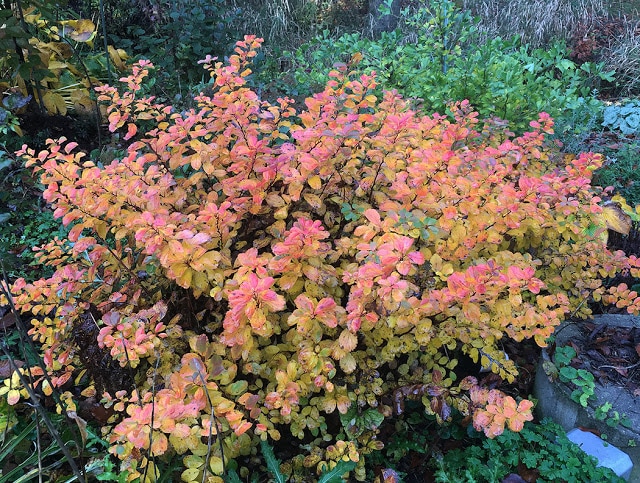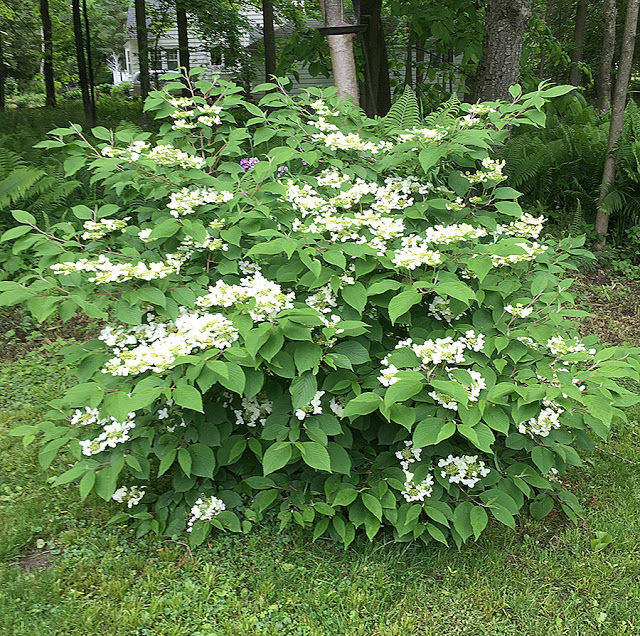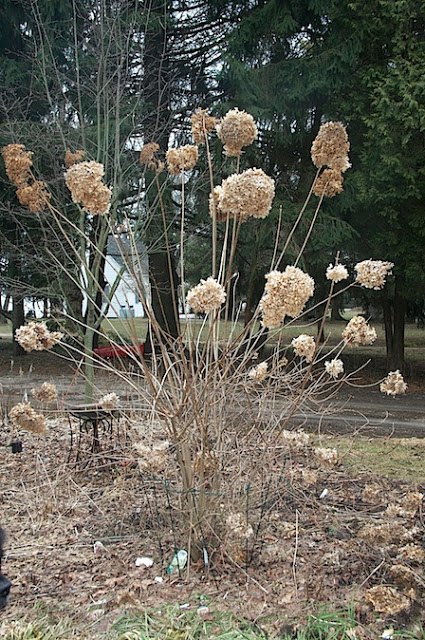- We’ve all been scolded and made to feel bad/silly/stupid for pruning incorrectly.
- We live in perpetual fear of killing plants by pruning incorrectly.
 |
| This is a newer cultivar of Spirea that only gets lightly shaped after blooming, but older varieties can turn into woody, ugly behemoths if not pruned at all. |
Of course there are finer points that go well beyond these. As gardeners get more into gardening, as is usually the case, these details become second nature. But in the meantime I feel like the gardeners who know those details are doing a good job of scaring the pants off new gardeners who may quickly decide that gardening is too complicated and they don’t have time or space in their brain for such details. And that’s sad, because while it is certainly better to have intimate knowledge of how and when to prune every plant we grow, the world will not end if you don’t.
In other words, let’s stop spreading the fear of pruning.
In fact, while some people may tell you that you MUST prune at a certain time, I’d like to challenge that idea. And by the way, I’m not alone. Christopher Lloyd, the late, great British gardener who did much to influence how we think of gardens today at his Great Dixter, has said that the best time to prune is when you have the tools in your hand and you think of it.
“The wrong time may be the only opportunity and a preferable alternative to not doing something at all,” he wrote in The Adventurous Gardener. “Or it may not be the wrong time, contrary to accepted practice as quoted in gardening literature, if you act cannily. It’s all very well to accept received advice and opinions gratefully and at face value when you’re starting, but we graduate. You’ll make mistakes but you’ll perhaps learn not to mind making them. That’s a great release from all sorts of inhibitions.”
In other words, it’s far better to prune at the wrong time than it is to not prune at all, which is a far more common and possibly egregious crime against horticulture. (Exception: There are many shrubs, that, when planted in an appropriate location can and should be allowed to live their lives with little to no pruning, short of removing dead wood.)
 |
| I planted this Viburnum plicatum ‘Mariesii’ in an area where it will be allowed to grow to its full size, maybe 10 feet tall and wide or more, so I will never need to prune it for size. |
Sometimes, when considering doing something in life that I’m not entirely comfortable with, I think, “What’s the worst that could happen?”
And I believe that might be a good approach to pruning as well. If you have the time and the tools handy, what’s the worst that could happen if you prune a shrub at a less than optimal time? And in most cases the answer is that you’d negatively affect its next flowering period. So is that so terrible? Well, it probably is if it’s the shrub around which you planned your entire garden, or if you have a garden wedding planned specifically for when a particular shrub blooms.
To me, the worst-case scenario of something that could happen to a shrub is that you’d kill it, and providing that you follow the other two rules (particularly the one about how much to prune), it’s unlikely you’ll do that.
Now think about the worst-case scenario if, year after year, you forget to prune a shrub when you are supposed to and never touch it because you don’t want to prune at the wrong time. You may end up with an overgrown shrub that outgrows its location and is so badly shaped that it can’t be salvaged. And then you end up taking it out, probably after several years of looking at a pretty ugly shrub. In effect, you make the decision to end it’s life.
The point is this: No one wants to reduce flowering accidentally, but I think it’s time we stop acting like pruning at the wrong time is one of the seven deadly sins. Not to mention, Lloyd’s point about making mistakes is a good one: Sometimes it’s the best way to learn in the garden.
Rather, I’d counsel gardeners to check a good gardening reference book or even Google (add .edu to the end of your search and you’re more likely to quickly get to more reliable information) for pruning information for their specific plant if they know what it is. But if you don’t and you have the tools in your hand and you know it’s likely the only time you’ll have for the job, go for it.
What’s the worst that can happen?



10 Responses
Light pruning. Otherwise its sadistic gardening.
Love this! My passion has always been perennials, but I'm trying to incorporate more shrubs into my gardens, with the thought that they will be less work. I'm definitely not afraid to prune, but always worry that I'm not doing it at the right time. Now I won't worry. Thanks!
My roses are going like crazy. They've grown three two feet since August!! When is the best time to cut them back? They are all Knock-outs. Thanks for all your great tips. I read them all.
Hi Jill, it depends a little bit on where you live. In warmer zones (maybe 7 and up) it is recommended that you prune in fall. In my garden I don't prune in fall (unless, say, a cane is flopping in the middle of a path), because I know I'll have some winter dieback and I find it best to deal with that before I start worrying about shape. I try to prune in spring just as buds are breaking, but I prune off anything that is truly dead ASAP regardless of the time of year.
I have very little pruning to do, my unwelcome herd of urban deer are doing more than their share. Since they have finished pruning all my perennials, even those that according to plant descriptions they have no interest in, they have now moved on the my shrubs and are using the trees we planted this spring as rubbing posts, breaking off limbs, girdling the trees. I'll be lucky to have anything surviving when spring comes. What the deer miss the squirrels and rabbits have gnawed off. Nothing is safe. When I lived in the country, we never had deer damage, now I can't enjoy anything I plant. All summer they ate off all the flowers. We have a herd of 7 deer who claim our yard as their own. We come around to corner of our house and meet them coming from the other direction in broad daylight, look out to the end of our driveway, and there they stand. They eat my potted plants that are at my front door, sitting against my house. It's hopeless! Oh, for the problem of whether to prune in fall or spring. I long for the opportunity to make that decision.
Oh those damn deer! I feel your pain as we have a lot of deer pressure in our yard too. For the last few years I've been using Messina's Deer Stopper (concentrated, then diluted in a pump sprayer) and so long as you reapply every couple weeks or after a super heavy rainfall, it works well for me. (I don't get it for free or anything, just a product I use and recommend.) Plantskydd also seems to work, but it smells terrible so that's why I prefer the Deer Stopper, which has a more pleasant odor.
I'm on the "too scared to prune for fear of doing something wrong" team and have some really overgrown things that have SOS flags flying. However, you've changed that thought process for me with this blog. Worst case scenario, I kill it and start over. That sounds way better than looking at the ugly I have going on. So, thanks for that!
I think the only rule I follow is doing it with enough time for new growth to harden off before winter. Mark usually does most of the pruning. I often touch up if I think he should have done more etc. Marisii is a stunning plant. We had one that was mature and massive and it died during a really bad winter. The loss of it gave us the impetus to do the stone steps and driveway wall.
Funny you should write this. I have been out snipping away. Mainly I have been snipping off dead, unruly limbs.